Botanic Garden and Attenborough Arboretum
Garden preview
Water Garden
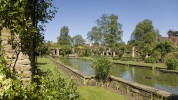 The Water Garden is flanked by pillars and ropes on which are trained climbing and rambling roses. In the pool grow a range of water lilies, among which the pale pink 'Marliacea Rosea' is outstanding. A variety of climbers scramble over the pergola which crosses the axis of the water garden at its northern end. These include a purple leaved form of the Grape vine, whose dark purple grapes yield a harsh juice.
The Water Garden is flanked by pillars and ropes on which are trained climbing and rambling roses. In the pool grow a range of water lilies, among which the pale pink 'Marliacea Rosea' is outstanding. A variety of climbers scramble over the pergola which crosses the axis of the water garden at its northern end. These include a purple leaved form of the Grape vine, whose dark purple grapes yield a harsh juice.
Sunken Garden
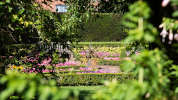 Beyond the Pergola is the Sunken Garden. This is a parterre of small beds laid out on a brick pavement, each bed edged with a dwarf form of Box. A traditional rotation of spring and summer planting is maintained in these beds.
Beyond the Pergola is the Sunken Garden. This is a parterre of small beds laid out on a brick pavement, each bed edged with a dwarf form of Box. A traditional rotation of spring and summer planting is maintained in these beds.
Hardy Fuchsia Collection
Bordered by a Yew hedge, the Conservation Garden contains a special collection of hardy Fuchsia, which are at their best from late August to October.
Desert House
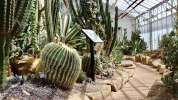 Succulence in plants is associated with very dry or salty environments and involves the production of a group of special characters, such as massive fleshy, water-storing organs; spines or sharp pointed leaves; and often a special mode of photosynthesis whereby carbon dioxide is taken into the plant at night, rather than during the day. The display contains not only members of the cactus family but also other plants that have adopted a similar habit.
Succulence in plants is associated with very dry or salty environments and involves the production of a group of special characters, such as massive fleshy, water-storing organs; spines or sharp pointed leaves; and often a special mode of photosynthesis whereby carbon dioxide is taken into the plant at night, rather than during the day. The display contains not only members of the cactus family but also other plants that have adopted a similar habit.
Beaumont House and Terrace
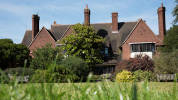 Beaumont House (known as 'Middlemeade' until 1947) was built in 1904 for Mr FS Brice, a Leicester hosiery manufacturer. The sheltered south-facing wall is home to some tender plants, such as the evergreen Magnolia grandiflora, a native of the southern United States whose sweet scented flowers open a few at a time from July to late autumn. Nearby are the Chilean Azara serrata and a vigorous specimen of Rosa banksiae 'Lutea', whose double yellow flowers appear in June. The terrace beds in front of the house have been planted with evergreen, summer-flowering shrubs, chiefly from the Mediterranean region.
Beaumont House (known as 'Middlemeade' until 1947) was built in 1904 for Mr FS Brice, a Leicester hosiery manufacturer. The sheltered south-facing wall is home to some tender plants, such as the evergreen Magnolia grandiflora, a native of the southern United States whose sweet scented flowers open a few at a time from July to late autumn. Nearby are the Chilean Azara serrata and a vigorous specimen of Rosa banksiae 'Lutea', whose double yellow flowers appear in June. The terrace beds in front of the house have been planted with evergreen, summer-flowering shrubs, chiefly from the Mediterranean region.
Sandstone Garden
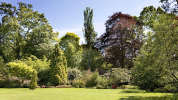 Lying between the two lawns in front of Beaumont House, the Sandstone Garden is dominated by a mature collection of Japanese Maples, cultivars of both Acer palmatum and A. shirasawanum. Cultivated by the Japanese for centuries, these species have produced a wide array of forms differing in leaf colour and shape. Particularly impressive is a specimen of A. shirasawanum 'Aureum' which carries golden yellow leaves throughout the summer, and in the autumn A. palmatum 'Aconitifolium' often provides a splendid display of turkey-red leaves. In late winter the clean trunks of the maples are complemented by large drifts of the lavender-coloured Crocus tommasinianus.
Lying between the two lawns in front of Beaumont House, the Sandstone Garden is dominated by a mature collection of Japanese Maples, cultivars of both Acer palmatum and A. shirasawanum. Cultivated by the Japanese for centuries, these species have produced a wide array of forms differing in leaf colour and shape. Particularly impressive is a specimen of A. shirasawanum 'Aureum' which carries golden yellow leaves throughout the summer, and in the autumn A. palmatum 'Aconitifolium' often provides a splendid display of turkey-red leaves. In late winter the clean trunks of the maples are complemented by large drifts of the lavender-coloured Crocus tommasinianus.
Limestone Garden
The Limestone Garden is dominated by a well-grown specimen of Bristlecone Pine, the tallest in the country (9.1m in 1981). In the wild the species grows at high elevations in the Californian Sierra Nevada, where some trees have been dated as being nearly 6,000 years old, among the oldest living things on the planet. The Limestone Garden itself is arranged on a geographical theme, with the mountain floras of America, Europe and Asia all represented. A smaller island towards the northern end contains British species.
Alpine House
One side of the Alpine House contains plunge beds in which is grown a diverse array of alpines. The other side features a collection of species that occur wild only in the Balearic Islands. This is both a conservation collection and a teaching resource, supporting an undergraduate course.
Southmeade House
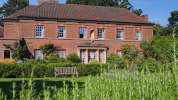 Southmeade House was built in 1928 for Mr Brice when he retired and left Beaumont. Its terrace provides a sheltered pocket for plants from Mediterranean climates. Here may be seen a large specimen of Azara microphylla from Chile, Jamesia americana (a white-flowered relative of Hydrangea from California), the Moroccan Broom, with yellow, pineapple-scented flowers, from North Africa, and Cistus and Euphorbia species from Europe.
Southmeade House was built in 1928 for Mr Brice when he retired and left Beaumont. Its terrace provides a sheltered pocket for plants from Mediterranean climates. Here may be seen a large specimen of Azara microphylla from Chile, Jamesia americana (a white-flowered relative of Hydrangea from California), the Moroccan Broom, with yellow, pineapple-scented flowers, from North Africa, and Cistus and Euphorbia species from Europe.
Herb Garden
 Dominated by a pair of Mulberry Trees, and edged with hedges of dwarf Lavender and rosemary, the Herb Garden is planted with medicinal and culinary plants, often aromatic members of the mint family, such as sage, bergamot, Nepeta and thyme. The lower part of the Garden features two pavements illustrating Fibonacci spirals.
Dominated by a pair of Mulberry Trees, and edged with hedges of dwarf Lavender and rosemary, the Herb Garden is planted with medicinal and culinary plants, often aromatic members of the mint family, such as sage, bergamot, Nepeta and thyme. The lower part of the Garden features two pavements illustrating Fibonacci spirals.
Order Beds
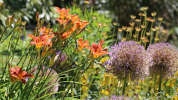 Between Southmeade Lawn and Hastings Glasshouse lie the Order Beds. About 30 flowering plant families are displayed, representing all the larger ones native to the British Isles. Our beds are rather unorthodox in that they are designed in the form of two 'snakes', one for dicotyledon families and one for monocotyledon families. On the north-facing side of the wall and by the western hedge are perimeter beds which house the National Collection of the genus Skimmia.
Between Southmeade Lawn and Hastings Glasshouse lie the Order Beds. About 30 flowering plant families are displayed, representing all the larger ones native to the British Isles. Our beds are rather unorthodox in that they are designed in the form of two 'snakes', one for dicotyledon families and one for monocotyledon families. On the north-facing side of the wall and by the western hedge are perimeter beds which house the National Collection of the genus Skimmia.
Warm-temperate and Tropical Glasshouse
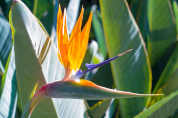 Featured in the warm-temperate section is a variety of species, including the Bird-of-Paradise Flower and a small collection of palms and cycads. Look out also for the insectivorous plants: sundews, flytraps and pitcher plants. The tropical section recreates a rainforest environment but also displays a collection of economically important plants, such as bananas, coffee, rice, sugar cane, mango and pineapple. It also features a small display about Alfred Russel Wallace and Henry Walter Bates, two former residents of Leicester who made significant contributions to our understanding of how evolution works.
Featured in the warm-temperate section is a variety of species, including the Bird-of-Paradise Flower and a small collection of palms and cycads. Look out also for the insectivorous plants: sundews, flytraps and pitcher plants. The tropical section recreates a rainforest environment but also displays a collection of economically important plants, such as bananas, coffee, rice, sugar cane, mango and pineapple. It also features a small display about Alfred Russel Wallace and Henry Walter Bates, two former residents of Leicester who made significant contributions to our understanding of how evolution works.
Hastings House
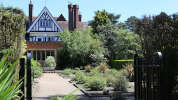 Hastings House (known as 'Nether Close' until 1947) was built in 1902 for Mr Stevens, a Leicester hosiery manufacturer. The design is apparently based on that of Old Ragdale Hall, near the Leicestershire village of Rotherby. Warmth-loving species grow against the wall of the house and fronting the terrace is the largest Wisteria sinensis in the garden, almost certainly dating from the original planting in the early 1900s.
Hastings House (known as 'Nether Close' until 1947) was built in 1902 for Mr Stevens, a Leicester hosiery manufacturer. The design is apparently based on that of Old Ragdale Hall, near the Leicestershire village of Rotherby. Warmth-loving species grow against the wall of the house and fronting the terrace is the largest Wisteria sinensis in the garden, almost certainly dating from the original planting in the early 1900s.
Cedar Grove and Giant Redwood
On the far side of Hastings House lawn is a grove of Cedars. On the left is the grey-leaved variant of the Atlas Cedar from North Africa; in the middle is the Cedar of Lebanon from the Near East; and on the right is the Deodar Cedar from the Himalayas. Across the path further to the west is a young specimen of a fourth species, the Cyprus Cedar, planted in 1982 by TG Tutin, Emeritus Professor of Botany at Leicester University, to commemorate the founding of the Botanic Garden in 1921/22.
At the western end of the Cedar Grove is a fine example of a Giant Redwood. In the wild these trees may reach over 100m high and live to be over 3,000 years old. Native to the Sierra Nevada of California the species is notable for its spongy bark which provides insulation against the wildfires which periodically sweep through natural populations.
Hastings East Side and Pinetum
Many of the Garden's coniferous species are to be found in this area. Notable specimens include the following:
- Giant Redwoods, including a curious pendulous form, looking very gothic.
- Dawn Redwood, a plant known only as fossils until living trees were discovered in the mountains of eastern China in 1941.
- Grand Fir, the tallest tree in the garden at 24m.
- Highland Pine, a native variant of the Scots Pine and collected from the Black Wood of Rannoch in Perthshire, one of the few remaining stations of the formerly widespread Caledonian pine forest.
Meadow
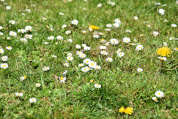 The Meadow is quite a good example of 'unimproved', neutral grassland, now rare in Leicestershire, and contains over eighty native British species, including Adder's Tongue Fern, an indicator of undisturbed pasture, and Yellow Rattle, a species which parasitises many of the meadow grasses. Nearby an old Field Maple is all that remains of an old hedgerow that dates back to the 1760 Enclosure Act for this area.
The Meadow is quite a good example of 'unimproved', neutral grassland, now rare in Leicestershire, and contains over eighty native British species, including Adder's Tongue Fern, an indicator of undisturbed pasture, and Yellow Rattle, a species which parasitises many of the meadow grasses. Nearby an old Field Maple is all that remains of an old hedgerow that dates back to the 1760 Enclosure Act for this area.
Paddock
This area was formerly a paddock and now contains a planting of trees characteristic of northern hemisphere woodlands, including species of birch, alder, maple and sweet gum, the last displaying impressive autumn colouring. Providing an evergreen accent are various tree heaths, bearing sprays of white flowers and fresh green foliage. Of special interest in the western-most planting is a group of Lodgepole Pines, collected in the wild from five localities ranging from Alaska to Oregon. They show genetic differentiation in height very clearly, with the northern collections being smaller than those originating from further south.
Holly Walk and Tennis Lawn
Leading northwards from the heather beds on the far western side is Holly Walk, so named because most of the garden's collection of hollies is planted along its route. The adjacent lawn (which used to be a tennis court) has been planted with a collection of Lawson's Cypress, a temperate rain-forest species.
The Knoll, Lawn and Pond
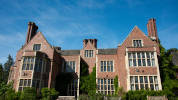 The Knoll was constructed for Mr William Winterton, a local brick manufacturer, in 1907 with specially made tudor bricks and roofed with local Swithland slates. Later occupied by Mr ES Fox (of Glacier Mints), the house was bought by the University in 1964. In the middle of the lawn is an old oak, a field tree dating from the last century. Nearby, is a pond planted with aquatic and marsh plants, including Gunnera tinctoria, a Chilean species with huge leaves and prickly leaf-stalks.
The Knoll was constructed for Mr William Winterton, a local brick manufacturer, in 1907 with specially made tudor bricks and roofed with local Swithland slates. Later occupied by Mr ES Fox (of Glacier Mints), the house was bought by the University in 1964. In the middle of the lawn is an old oak, a field tree dating from the last century. Nearby, is a pond planted with aquatic and marsh plants, including Gunnera tinctoria, a Chilean species with huge leaves and prickly leaf-stalks.